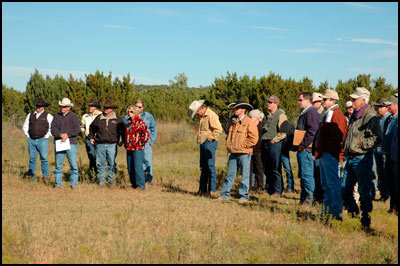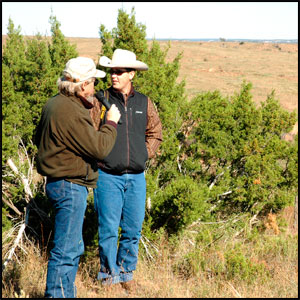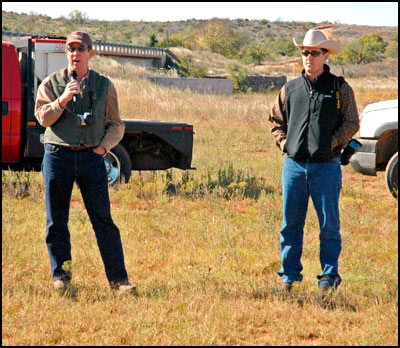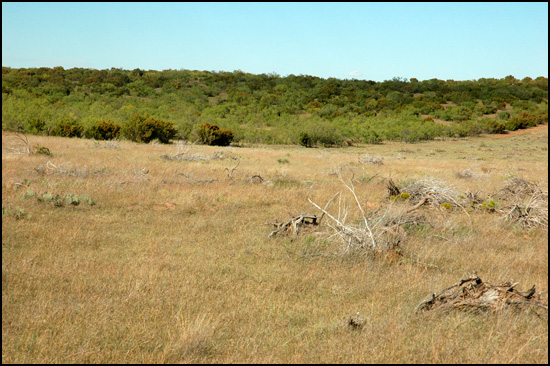Prescribed Burning
a Tool for Brush Management
Ranch owners tell the good, the bad and the ugly.
The sprawling JA Ranch has seen its share of fires — some intentionally set and some not. Ranch managers now are looking at the results of the fires to help determine how prescribed fire could be used for brush management on their property.
Texas AgriLife Extension Service officials conducted a field day on the JA Ranch, located southeast of Amarillo in Armstrong and Donley counties. During the course of the day, ranch operators and AgriLife Extension and Texas AgriLife Research experts discussed various treatments and results.

The crowd listens as speakers explain different possible treatments for the thick canopy of juniper behind them.
Redberry juniper and mesquite so thickly cover many of the pastures on the ranch that it is difficult to gather cattle from pastures, said Andrew Bivins, one of the ranch owners and current leader of the Panhandle Prescribed Burning Association.
"Some of these pastures we can't aerial spray because there is too much juniper, and it's too rough to grub it," Bivins said.
Considering options
A prescribed burn takes time to properly plan, he said. And sometimes even after taking the management practice to defer grazing to build up fuel for the fire and burning blacklines, the weather doesn't cooperate for the burn.
"To top-kill the juniper, you need moisture levels down where the canopy will burn and enough grass where it will carry the fire from tree to tree," said Jim Ansley, Texas AgriLife Research range management scientist from Vernon.
"The problem with juniper densities like this is you could defer this for 10 years and not get rid of the bare patches," Ansley said. "You may have to do some mechanical treatment to open it up some and get more grass growing."
He said an option would be to burn smaller portions of the pasture on the north and east sides first with fairly conservative fires that have preburned blacklines. Then one could possibly push the limits in terms of humidity and air temperatures for a hotter headfire on the southern sections, assuming the burn occurs with a south or southwest wind.
The limits would include coming close to but not below the 20% humidity level, air temperature between 70° and 80° F and wind speeds between 10 mph and 20 mph.
"If you don't mechanically treat it first and want fire to do the job, you are going to have to push the limits," Ansley said. "But this is not the most desirable situation."

Ted McCollum, Texas AgriLife Extension Service beef cattle specialist in Amarillo, discusses with Andrew Bivins the treatment — grubbing and a spring burn — that was made on the boggy pasture behind them.
The key, said Ted McCollum, AgriLife Extension beef cattle specialist in Amarillo, is to not let the situation get to the point where the juniper trees have to be used to move the fire.
Wildlife vs. livestock perspective
Ken Cearley, AgriLife Extension wildlife management specialist, said looking at it from a wildlife perspective, it would be best to leave a mosaic of plant communities in the pasture.
"If other woody cover is lacking, some cedar is better than no cedar for wildlife," Cearley said. "If you end up not killing all of it, it's not a bad thing. Historically, cedar existed in rougher country that protected it from naturally occurring wildfires and provided thermal and screening cover for deer, for example."
He suggested sometimes turning cattle in on the burned pasture a little early if quail were a major part of the operation's plan, because that would encourage the growth of forbs, weeds favored by wildlife that are necessary for their habitat.
Frequent use of this strategy could encourage the success of invasive brush, however, due to the lessened competition with grasses, Cearley said. Deferment through a full growing season would more likely be in order if livestock production is the priority.
Mesquite might not be prime cover for quail, but if it is basically the only woody plant available, it can be managed for their use, he said.
Cearley also said burning as early as possible in the winter will generally benefit forbs, though a good grass cover can still be expected come springtime with deferment.
Burning later in the winter, just before spring green-up, will favor grasses and, therefore, livestock production.
In their boggy pasture, Bivins said they spent two years to get 2,000 acres grubbed and then deferred it for a year before burning it in 2003. The grubbing/burn combination did a good job of cleaning up the brush growth.
Practical example
"We like to wait a year or two after grubbing before we burn, but you don't want to wait too long," he said.
Bivins also said that everything didn't catch fire the first day and he and his mother went out the next two days with drip torches, walking around and lighting fires to get better coverage.
He estimated it takes $120 an acre to grub, so what they have started doing on the ranch is bulldozing two lines 100 yards apart and grubbing in between. They then let that area sit for a year before burning it as a black line. This procedure is followed by fire across the rest of the pasture.
"To keep the mesquite suppressed you really should burn it every six to seven years," Ansley said. "Redberry juniper has a slower regrowth and you can get by with 10-year intervals."
He said in studies of mesquite seedlings, they discovered that the growth node can slip back under the soil surface in the early stages of growth to protect it from fire, so earlier burning may not do a good job.
"While fire may be very hot at the soil surface, at a half-inch down in clay soils, you won't have any temperature difference," Ansley said.
He said summer is when many of the wildfires started years ago, and while it may not be the practice now, they have benefits. Summer fires have a higher duration of extreme heat, which can top-kill brush species easier.
"We don't recommend it in cedar country, but with mesquite and prickly pear, it's doable and more effective," he said.
Warm-season grasses may be delayed by a summer fire, but the long-term data show that after a few years, the reverse happens, Ansley said.
"We have more warm-season mid-grasses replacing warm-season short grasses like buffalo grass," he said. "So in the long run, if you can arrange a management scheme where you can tolerate the slower recovery, a summer fire will be better."
Ansley said his studies also have shown that if mesquite is only top-killed, the original canopy cover as a percentage of ground area returns within just a few years because of rapid multi-stemmed regrowth. Mesquite regrowth has more leaf area than before and can become a greater problem than the plant was previously.
Another option for mesquite management is to apply treatments that maintain top-kill and maintain the mesquite canopies as a savanna, he said.
Low-intensity fires or spraying Reclaim® by itself can be used for this option, Ansley said. These treatments will reduce the canopy foliage to about one-third the size and keep the mesquite from resprouting.
McCollum said resprouting replaces single- or double-stemmed mesquite trees with multiple-stemmed trees.
J.F. Cadenhead, AgriLife Extension range specialist from Vernon, said several years could pass following a spray with something like a Reclaim/Remedy™ mix before a follow-up maintenance burn is needed.
However, a point of controversy related to this long-term strategy was raised when the field tour came to a pasture where the JA Ranch crew had followed such a plan.
Dale Smith, another member of the ranch management team and prescribed burn association, said a pasture was sprayed with a Reclaim/Remedy mix (a quarter pound each) in 2001. It provided good control with most of the mesquite appearing dead.
However, about five years after they sprayed, they applied a prescribed fire to clean up the dead stems. While it initially looked good, two or three years later the mesquite began to resprout. This is causing a major concern regarding long-term planning.

Jim Ansley, Texas AgriLife Research range management scientist from Vernon, and Andrew Bivins discuss approaches to controlling juniper with a prescribed fire.
Ansley said there obviously was not a true root kill, but he could not explain what had happened. He and Cadenhead agreed that this had not been seen before and was a major concern.
Another possible brush control method that is being tried in some areas is using herbicides normally used for weeds every three years in a mesquite-suppression program, Cadenhead said. While the mesquite will come back, the three-year application of herbicide is cheaper than the Reclaim/Remedy mix and it would keep the mesquite knocked back.
Cearley cautioned that, depending on which weeds are targeted, such a practice could remove weedy plants that are important to wildlife.
Comment on this article.





